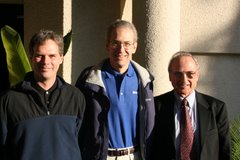I'm back from another well-attended aquifer testing short course held at the headquarters of In-Situ, Inc.on October 5 and 6, 2011 and the sixth consecutive year that we've traveled to Ft. Collins, CO to present
Aquifer Testing for Improved Hydrogeologic Site Characterization Featuring AQTESOLV and the In-Situ LevelTROLL.
 |
| Analysis of recovery data combining Agarwal method and derivative analysis. |
The course covered topics relating to designing, performing and analyzing both slug tests and pumping tests and included hands-on use of
AQTESOLV as a teaching tool. As part of my lectures, I spent a good deal of time going over the finer points of diagnostic methods for pumping tests including
derivative analysis, a technique widely practiced in the petroleum industry for well test analysis. I further introduced the class to the
Agarwal method for analyzing recovery tests which also drew a lot of attention.
Thanks to all who attended the course and to In-Situ for hosting us! I look forward to doing it again next year.










